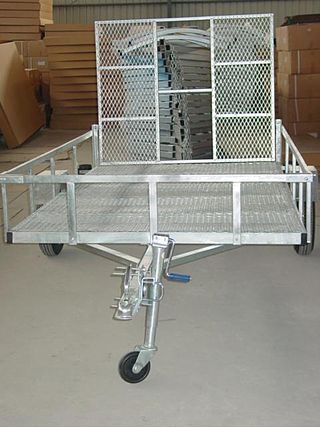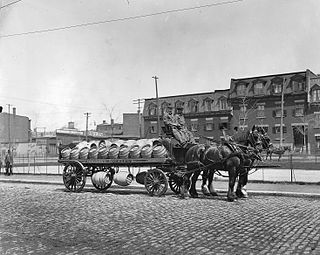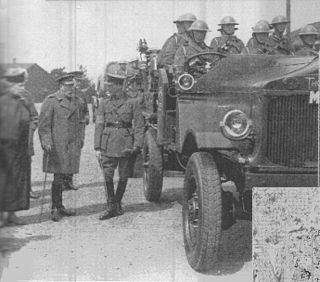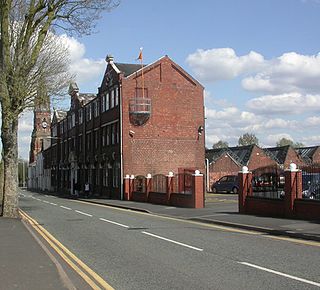

A lorry or lorrie was a low flat horse-drawn vehicle with no sides, related to the trolley and dray. [1] [2]


A lorry or lorrie was a low flat horse-drawn vehicle with no sides, related to the trolley and dray. [1] [2]
This version was a low-loading trolley used mainly for the carriage of other vehicles, for example for delivery from the coachbuilders or returning there for repair.
Its very small wheels were mounted under the deck which had to be wider than the track of the vehicles to be carried. It had two ramps, stowed above the back axle and below the body. These were withdrawn from the lorry and one end of each attached to the back of the deck while the other ends rested on the ground. A winch, mounted on the headboard was then used to draw the load up the ramps and onto the deck. The winch cable, low fixed sideboards and a low hinged tailboard plus lashings retained it there.
The lorry was rather like a wooden version of the modern car-carrying trailer, intended for towing behind a car, except that the wheels were wooden, with iron tyres and were not close-coupled. The front ones were on a steering undercarriage. The driver's seat was mounted on the top of the headboard.
Around 1900, the lorry developed a sturdier form for carrying the heavier motor cars. These motor car lorries were two-horse vehicles, partly because of the weight carried but also because the roll-resistance of the very small wheels had to be overcome. For the same reason, it was primarily an urban vehicle so that, on the paved roads, the small wheels were not an insurmountable handicap. In any case, the axles were sprung.
As in many fields, as time went by, people used the word perhaps without understanding its detailed meaning, so that it became applied less precisely and other configurations were given the name. By 1911, as the motor-propelled lorry (a kind of truck) developed, a pedant would have regarded it as being more the heir of the heavy trolley than of the horse-drawn lorry. However, the railway vehicles, first noted by the Oxford English Dictionary from 1838, were more like the horse-drawn road lorry. In these earlier years, it was also called a lurry. In Britain, "lorry" nowadays means any large powered truck.

A cart or dray is a vehicle designed for transport, using two wheels and normally pulled by draught animals such as horses, donkeys, mules and oxen, or even smaller animals such as goats or large dogs.

A wagon or waggon is a heavy four-wheeled vehicle pulled by draught animals or on occasion by humans, used for transporting goods, commodities, agricultural materials, supplies and sometimes people.

A traction engine is a steam-powered tractor used to move heavy loads on roads, plough ground or to provide power at a chosen location. The name derives from the Latin tractus, meaning 'drawn', since the prime function of any traction engine is to draw a load behind it. They are sometimes called road locomotives to distinguish them from railway locomotives – that is, steam engines that run on rails.

A trailer is an unpowered vehicle towed by a powered vehicle. It is commonly used for the transport of goods and materials.

A drive shaft, driveshaft, driving shaft, tailshaft, propeller shaft, or Cardan shaft is a component for transmitting mechanical power, torque, and rotation, usually used to connect other components of a drivetrain that cannot be connected directly because of distance or the need to allow for relative movement between them.

A dump truck, known also as a dumping truck, dump trailer, dumper trailer, dump lorry or dumper lorry or a dumper for short, is used for transporting materials for construction as well as coal. A typical dump truck is equipped with an open-box bed, which is hinged at the rear and equipped with hydraulic rams to lift the front, allowing the material in the bed to be deposited ("dumped") on the ground behind the truck at the site of delivery. In the UK, Australia, South Africa and India the term applies to off-road construction plants only and the road vehicle is known as a tip lorry, tipper lorry, tipper truck, tip truck, tip trailer or tipper trailer or simply a tipper.

A flatcar (US) is a piece of rolling stock that consists of an open, flat deck mounted on a pair of trucks (US) or bogies (UK), one at each end containing four or six wheels. Occasionally, flat cars designed to carry extra heavy or extra large loads are mounted on a pair of bogies under each end. The deck of the car can be wood or steel, and the sides of the deck can include pockets for stakes or tie-down points to secure loads. Flatcars designed for carrying machinery have sliding chain assemblies recessed in the deck.

A buckboard is a four-wheeled wagon of simple construction meant to be drawn by a horse or other large animal. A distinctly American utility vehicle, the buckboard has no springs between the body and the axles. The suspension is provided by the flexible floorboards of the body and a leaf spring under the seat(s). The buckboard has no sideboards on the body, leaving the floor quite mobile. In rough terrain, the floor can flex and "buck", lending the vehicle its name.

A horse-drawn vehicle is a piece of equipment pulled by one or more horses. These vehicles typically have two or four wheels and were used to carry passengers or a load. They were once common worldwide, but they have mostly been replaced by automobiles and other forms of self-propelled transport but are still in use today.

Among horse-drawn vehicles, a trolley was a goods vehicle with a platform body with four small wheels of equal size, mounted underneath it, the front two on a turntable undercarriage. The wheels were rather larger and the deck proportionately higher than those of a lorry. A large trolley is likely to have had a headboard with the driver's seat on it, as on a lorry but a smaller trolley may have had a box at the front of the deck or the driver seated on a corner of the deck and his feet on a shaft. With a very small trolley, the 'driver' may even have led the horse as a pedestrian. They were normally drawn by a single pony or horse but a large trolley would have a pair.

A drayman was historically the driver of a dray, a low, flat-bed wagon without sides, pulled generally by horses or mules that were used to transport all kinds of goods.

A semi-trailer is a trailer without a front axle. The combination of a semi-trailer and a tractor truck is called a semi-trailer truck.

A two-wheeler is a vehicle that runs on two wheels.

A flatbed truck is a type of truck the bodywork of which is just an entirely flat, level 'bed' with no sides or roof. This allows for quick and easy loading of goods, and consequently they are used to transport heavy loads that are not delicate or vulnerable to rain, and also for abnormal loads that require more space than is available on a closed body. Flatbed trucks can be either articulated or rigid.

A tank transporter is a combination of a heavy tractor unit or a ballast tractor and a mating full trailer, hydraulic modular trailer or semi-trailer, used for transporting tanks and other armoured fighting vehicles. Some also function as tank recovery vehicles, the tractors of which may be armoured for protection in combat conditions.

The Thornycroft Hathi was an early four wheel drive lorry built by Thornycroft in the 1920s. It was used by the British Army as an artillery tractor.

A float is a form of two-wheeled horse-drawn cart with a dropped axle to give an especially low load-bed. They were intended for use by deliverymen and the carrying of heavy or unstable items such as milk churns.
A flatbed trolley a common form of freight transport in distribution environments, for moving bulk loads. Trolleys can aid in reducing effort required to move a load by allowing the user to pull or push instead of lift and carry. A very simple design offers a basic flat platform with four casters and a fixed handle which is used to either push or pull the platform with the load on the platform. Without a flat surface it becomes an open frame trolley and without a handle it is a bogie or dolly.
The SLT 56 is a heavy duty tractor unit and tank transporter currently in use by the German Army.

Sunbeam Commercial Vehicles was a commercial vehicle manufacturing offshoot of the Wolverhampton based Sunbeam Motor Car Company when it was a subsidiary of S T D Motors Limited. Sunbeam had always made ambulances on modified Sunbeam car chassis. S T D Motors chose to enter the large commercial vehicle market in the late 1920s, and once established they made petrol and diesel buses and electrically powered trolleybuses and milk floats. Commercial Vehicles became a separate department of Sunbeam in 1931.
Dray. Heavy commercial or freight vehicle, usually drawn by a team of powerful draught horses. The first known type in Europe, used during the 17th century, was a mere framework on two wheels, having neither floors nor side planks/boards. Later and larger types may have been hung on side or cross springs and usually had four wheels. All were flat, without sides or raves, although some had removable side stakes, especially those for transporting barrels. While some had a raised seat for the driver other teams were led or controlled from a standing position. With an early brewer's dray the driver frequently sat on the first barrel. Known in American cities as a Transfer Dray.
Dray: See Lorrie. Lorrie: A strongly built, flat-topped, four-wheeled cart, which was hung on four sidesprings. It was used for transporting heavy goods such as sacks of coal or corn and could be pulled by a single horse with shafts, or a pair with either a pole or two pairs of shafts.